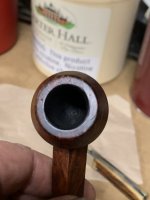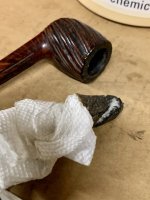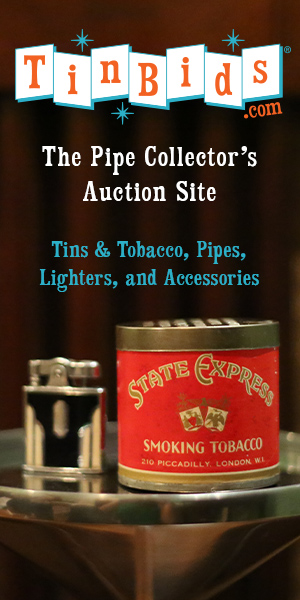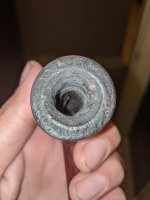I was taught by Harry Hosterman to put a cake inside the chamber the “thickness of a dime”, which is not quite five thousands of an inch (0.045” or 1.35mm). All the little brochures that used to come with drugstore pipes years ago also advised this.
For maybe ten years or so I tried that, and I will say a dime thickness cake does seem to insulate the pipe against burnout, if smoking outdoors.
I have all manner of pipe reamers designed to ream out a pipe. I don’t use them any more, because one slip and I’d gouge a chamber, or I’d remove briar instead of carbon. For years I’ve used only a sharp, sturdy pocketknife blade as a scraper.
Whether it’s a new pipe or an old one I try and get all previous carbon or built up cake completely off, down to bare briar.
Then I build a cake the thickness of a hair, or just a whisper, only enough to claim there is just a little carbon deposit inside the bowl.

Briar is rather a miraculous wood in that the burning ember of tobacco reaches nearly a thousand degrees Fahrenheit, most woods ignite at half that temperature, yet briar pipes build up carbon, instead.
And your charcoal briquettes, are pure carbon. Yet somehow the carbon in a pipe doesn’t burn away, it keeps growing until reamed or, as I prefer, I keep it down using an Everclear soaked, twisted paper towel.

So why do I contradict everything I was ever taught or read about caking a pipe?
I’m convinced a briar pipe breaks in from the extreme heat of the ember fully curing the briar, removing all the foul tasting tannins or whatever resins make a brand new pipe smoke hot and taste like burning briar. When I scrape an old pipe down to bare briar it doesn’t need another break in, unless the previous owner didn’t smoke it all the way down, which seems to be most of them. Once fully broken in, all the way to the draft hole, the pipe doesn’t require a thick cake to provide flavor.
I think leaving a thick cake does two bad things.
The worst is that cake is formed from tobacco residue that often goes rank and sour, and it’s liable to foul the smoke. A lesser evil is that cake cuts down on capacity, and I want all the tobacco it can hold,
When my time for being the custodian of my hoard of old pipes is through, the next man will be free to build up as much cake as he likes.
I do admit a razor thin cake is not advisable for smoking outdoors in the wind.
Which is a good excuse to dig out the Missouri Meerschaums.
For maybe ten years or so I tried that, and I will say a dime thickness cake does seem to insulate the pipe against burnout, if smoking outdoors.
I have all manner of pipe reamers designed to ream out a pipe. I don’t use them any more, because one slip and I’d gouge a chamber, or I’d remove briar instead of carbon. For years I’ve used only a sharp, sturdy pocketknife blade as a scraper.
Whether it’s a new pipe or an old one I try and get all previous carbon or built up cake completely off, down to bare briar.
Then I build a cake the thickness of a hair, or just a whisper, only enough to claim there is just a little carbon deposit inside the bowl.

Briar is rather a miraculous wood in that the burning ember of tobacco reaches nearly a thousand degrees Fahrenheit, most woods ignite at half that temperature, yet briar pipes build up carbon, instead.
And your charcoal briquettes, are pure carbon. Yet somehow the carbon in a pipe doesn’t burn away, it keeps growing until reamed or, as I prefer, I keep it down using an Everclear soaked, twisted paper towel.

So why do I contradict everything I was ever taught or read about caking a pipe?
I’m convinced a briar pipe breaks in from the extreme heat of the ember fully curing the briar, removing all the foul tasting tannins or whatever resins make a brand new pipe smoke hot and taste like burning briar. When I scrape an old pipe down to bare briar it doesn’t need another break in, unless the previous owner didn’t smoke it all the way down, which seems to be most of them. Once fully broken in, all the way to the draft hole, the pipe doesn’t require a thick cake to provide flavor.
I think leaving a thick cake does two bad things.
The worst is that cake is formed from tobacco residue that often goes rank and sour, and it’s liable to foul the smoke. A lesser evil is that cake cuts down on capacity, and I want all the tobacco it can hold,
When my time for being the custodian of my hoard of old pipes is through, the next man will be free to build up as much cake as he likes.
I do admit a razor thin cake is not advisable for smoking outdoors in the wind.
Which is a good excuse to dig out the Missouri Meerschaums.












